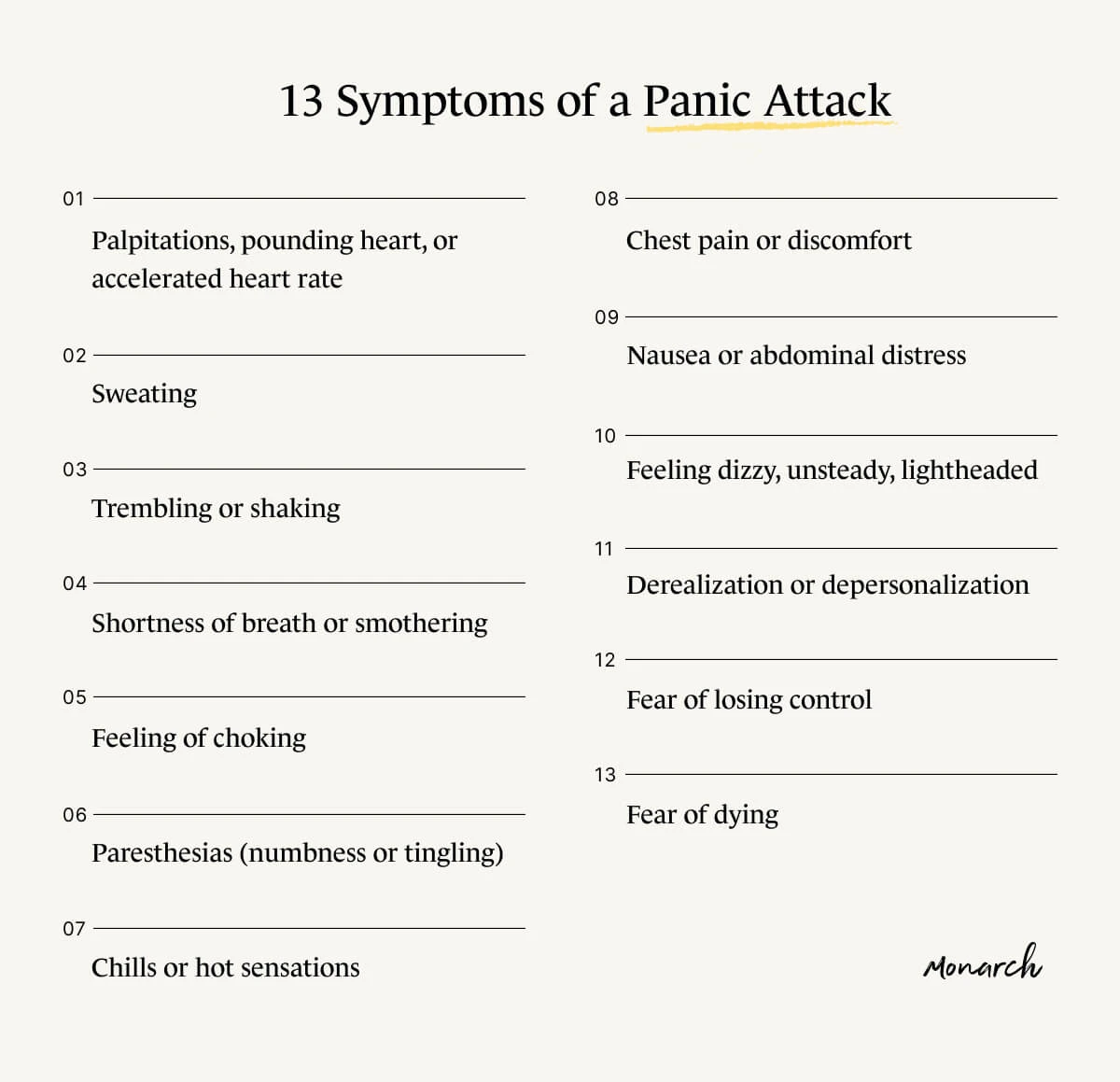Anxiety disorders are among the most common mental disorders in the U.S., impacting an estimated 40 million American adults every year, according to the Anxiety and Depression Association of America.
These disorders range in severity from occasional social anxiety to serious panic disorders, which are characterized by discrete fits of intense fear known as panic attacks.
Though they’re not uncommon, panic attacks are a bit harder to pin down and define in absolutes than parallels like asthma attacks.
Ahead, Dr. Nikki Rubin, PsyD, dispels some of the mystery around panic attacks, anxiety attacks, and the difference between the two.
What happens during a panic attack?
The DSM-5, the handbook healthcare professionals use to diagnose mental disorders, defines a panic attack as “an abrupt surge of intense fear or intense discomfort that will come to a sort of terrifying crescendo within a window of approximately ten minutes.”
The signs of a panic attack
Palpitations, pounding heart, or accelerated heart rate
Sweating
Trembling or shaking
Sensations of shortness of breath or smothering
Feeling of choking
Chest pain or discomfort
Nausea or abdominal distress
Feeling dizzy, unsteady, lightheaded, or faint
Derealization (feelings of unreality) or depersonalization (being detached from oneself)
Fear of losing control or “going crazy”
Fear of dying
Paresthesias (numbness or tingling sensation)
Chills or hot sensations
According to the DSM, panic attacks consist of four or more of these signs and symptoms within a ten-minute period, however, according to Dr. Rubin, this time frame can vary.
“When I’m assessing for panic attacks, I usually give a range of 10-to-20 minutes,” she says. “Once they begin, they increase fairly quickly, reach a peak/crescendo, and then begin to subside.”
The important thing to keep in mind is that these symptoms reach a kind of climax within a discrete period of time

What’s the difference between a panic attack and an anxiety attack?
Essentially, the difference between a panic attack and an anxiety attack is rhetorical.
While panic attacks have clinical factors one can point to—the phrase “anxiety attack” is more colloquial.
“People often use the term ‘anxiety attack’ as a catch-all for differing levels of intense anxiety symptoms, like feeling an increased heart rate and muscle tension for an hour,” Dr. Rubin says. “It’s not an official or clinical term—when patients tell me they experience ‘anxiety attacks,’ I have to assess specifically what this refers to.”
This speaks to the range of different anxiety mentioned earlier.
“Panic attacks usually occur within the context of an anxiety disorder, and this can be any anxiety disorder, such as OCD, PTSD, general anxiety disorder (GAD) as well as panic disorder with or without agoraphobia, she says. “Though having another type of anxiety disorder (e.g., GAD) does not mean that you will have a panic attack.”
How long do panic attacks last?
As awful as panic attacks are, they reach a peak, and then begin to subside generally within ten minutes.
If someone is experiencing two or three panic symptoms that—while very unpleasant and intense—do not reach a peak, they can tend to remain elevated for a longer period of time (e.g., someone feels intense nausea and a choking sensation for over an hour).”
For example, a person with social anxiety may experience a racing heart or uncomfortable sweating or trembling at a party and call that an anxiety attack, but that doesn’t clinically meet the definition of a panic attack.
The clinical definition of a panic attack is necessarily limited, and Dr. Rubin points out that, in reality, there’s an entire spectrum of panic attacks and panic attack symptoms.
In fact, some experiences we might call anxiety attacks or “not full-blown panic attacks” can actually be more distressing than panic attacks as clinically defined.
According to Dr. Rubin, individuals can experience panic symptoms that don't reach the level of a full-blown discrete panic attack.
“In my experience, sometimes these ‘subthreshold’ panic symptoms can be worse than a panic attack because they take much longer to subside,” she says.
What can trigger a panic attack?
Though it may seem that a panic attack has come out of nowhere, if you dig a little deeper, you can probably find a trigger.
When we think of causes for panic attacks, we tend to think of external triggers, such as if someone is afraid of dogs and they suddenly encounter a large dog while on a walk and their anxiety symptoms quickly intensify and peak in a panic attack.
However, triggers can be more obscure than that.
Can you have a panic attack for no reason?
Dr. Rubin points out that there can be internal triggers.
“Imagine someone’s shopping for groceries, a safe and familiar activity, when they begin to feel slightly lightheaded because they haven't yet eaten lunch. The brain then begins to cognitively evaluate this physiological sensation by asking ‘Why am I feeling so dizzy? This is weird, something must be wrong,'” she says. “And this, in turn, triggers anxiety/fear and the associated physiological sensations, which then triggers more cognitive evaluation, and more anxiety and sensations, and so on until the person has a panic attack.”

Are panic attacks dangerous?
“Absolutely not,” says Dr. Rubin.
Though they may subjectively feel like they’re extremely dangerous or even fatal (like a heart attack), it’s really important for people to know they can’t die from a panic attack.
The feeling of danger is just that: a feeling.
“The sensations of a panic attack are so intense,” says Dr. Rubin, “but that's all they are, just very unpleasant and uncomfortable physiological sensations that cannot hurt you in any way.”
Of course, there can always be an exception.
“If someone has a previously diagnosed cardiac issue, it’s always good to check with a physician who can help distinguish between their cardiac issue and anxiety symptoms,” says Dr. Rubin.

How do you calm a panic attack
According to Dr. Rubin, the best thing to do when you’re feeling panic attack symptoms is the thing you may feel least capable of doing.
“First, pause and remind yourself that panic attacks, and anxiety in general, cannot physically hurt you in any way,” she says. “Acknowledge that the sensations are very uncomfortable, but that they are not dangerous.”
“Next, mindfully observe and label/name what you are feeling,” says Dr. Rubin. “Literally: ‘'My heart rate is increasing, and that's uncomfortable’ or ‘I feel a little nauseated—my palms are sweating.’”
This can help ground you in reality.
“While the urge will be to try and escape the sensations, attempting to fix/avoid/run away from/question them will actually intensify them,” she says. “By mindfully observing and labeling what you are feeling, you will not only begin to ground yourself—you can also help stop the escalation of the symptom intensity.”
Treatment for panic attack
If you think you’d be helped by a more physical approach, Dr. Rubin recommends literally focusing on your surroundings.
“You can focus your attention on feeling your feet firmly on the ground while you are sitting or standing,” she recommends. "Look at the sky, the room you are in, the people around you—mindfully observe/label/name what you see and experience in the moment.”
And remember, this too shall pass.
“Whether or not the symptoms reach a peak, they will pass,” says Dr. Rubin. “Panic attacks do not last forever because emotions do not last forever. They come and go like waves, even when the waves are really big.”
In the longer term, you might want to consider speaking with a licensed expert, such as a medical doctor, a therapist, a counselor, or a psychiatrist.

Find a therapist near you who specializes in anxiety
You can use the Monarch directory by SimplePractice to find therapists experienced in treating anxiety and panic attacks. You can even book free consultations and appointments online.
According to Dr. Rubin, panic attacks are very treatable.
”Cognitive-behavioral therapies (CBT) are the standard of care for anxiety disorders in general, including panic attacks and panic symptoms,” she says. "Psychiatric medication may also be an option, though panic attacks can sometimes resolve with CBT alone. (By the way, needing medicine isn't a failure of CBT or the patient—some people simply have brains that need medical support, and CBT-plus-medication is well studied as an effective combination).”
Though panic attacks can present themselves differently in different people, one characteristic they tend to share is that they feel terrifying to the sufferer.
Being aware of this may be the first step toward self-soothing the next time this terrifying sensation occurs.
Talking to someone may help.
Find a therapist near you who specializes in treating anxiety and panic attacks.
Do I have an anxiety disorder?
To find out if you have symptoms of an anxiety disorder, take our free 2-minute anxiety quiz. While the results cannot replace a clinical diagnosis, they can help you monitor your mental health.
READ NEXT: What’s the Difference Between Stress and Anxiety?
Need to find a therapist near you? Check the SimplePractice Monarch Directory to find licensed mental health therapists with availability and online booking.
American Psychiatric Association. (2013). Diagnostic and statistical manual of mental disorders (5th ed.). Washington, DC: Publisher.
Anxiety and Depression Association of America (ADAA). (2020). Facts & statistics. Retrieved from https://adaa.org/about-adaa/press-room/facts-statistics
Cleveland Clinic. (2020). Panic attacks: Panic disorder, anxiety disorder, symptoms, causes. Retrieved from https://my.clevelandclinic.org/health/diseases/4451-panic-disorder
Psychiatry.org. (2017). What are anxiety disorders? Retrieved from https://www.psychiatry.org/patients-families/anxiety-disorders/what-are-anxiety-disorders
Anxiety and Depression Association of America: https://adaa.org/understanding-anxiety/facts-statistics#:~:text=Did%20You%20Know%3F,of%20the%20population%20every%20year





